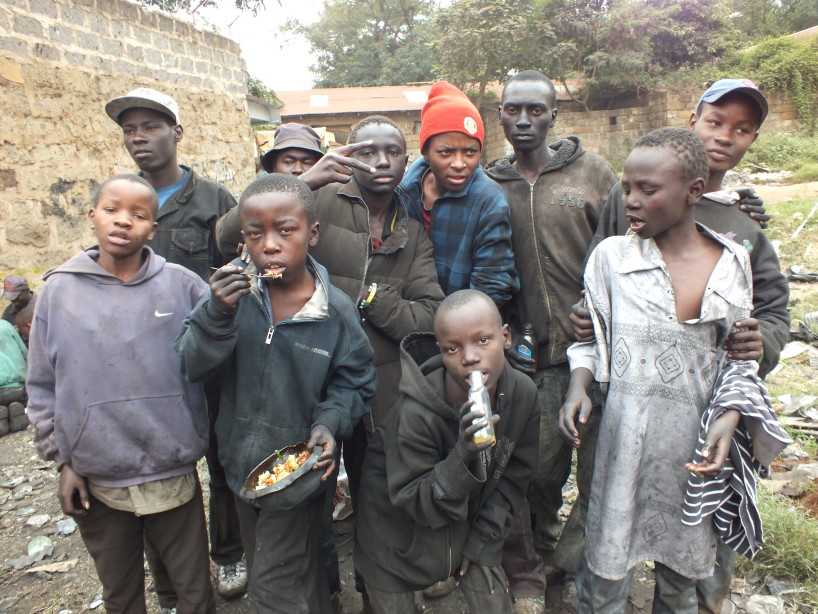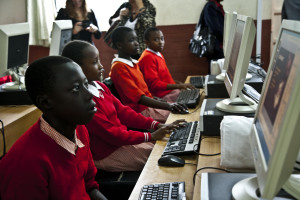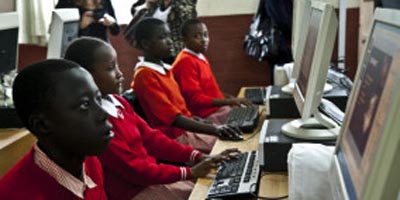
When people walk through the city streets of Nairobi they are often confronted by the pleading hand of a child. Street children, called chokoras in Kiswahili slang, are outcasts of everyday society in Kenya. They are seen wandering through the city in search of shelter, drinking water and food, in their daily activities of begging, substance abuse and evading arrest.
The alternatives to being on the street are limited to anything from abusive homes to underground social circles, says Juma Assiago, an urban safety expert in the UN-Habitat’s Safer Cities Programme. “What is not good, with the question of having children on the streets, is that they did not have another option.”
For diplomatic purposes, however, the Kenyan government may choose to consider its options. For example, the three months I spent in Nairobi coincided with the visit by US President Barack Obama. The city is normally busy and active, with vehicles continuously flowing through the city, but during the week before his arrival the city had to prepare for three of its major roads to be closed off, including public transport routes. During this time entering the city felt like visiting an unfamiliar place. The most striking difference was not the lack of cars, but rather the notable absence of all street children. Kenyan media later reported that the city council had rounded the children up to be dropped off in neighbouring towns without their consent, to “cleanse” Nairobi’s appearance.
Under the Kenyan Bill of Rights, children are afforded the right to, among other things, a name and nationality at birth, shelter, basic nutrition, and parental care. Unfortunately, the reality for the approximate tens of thousands of street children is the denial of these rights. Several pressures have contributed to their increasing marginalization.
Following the post-election violence that broke out in 2007/08, more than 600,000 people were internally-displaced, including children. (The situation was described in a 2014 Amnesty International report.) Kenya’s democratic state is less than two generations old, adding to the limits of public policies geared towards children’s needs, and people are especially disillusioned with the public justice system.
In trying to meet their needs by themselves, street children become part of an informal economy and distanced from members of everyday “working” society. In many cases this may be despite belonging to a home or having guardians. Public perception has to move away from one of the children on the streets being inextricably related to poverty, Assiago says. In fact, street children need not be homeless. Some of them may instead have decided to seek a livelihood on the streets out of personal volition or because of inter-personal pressures. So it is important to examine how failing institutions may contribute to putting children into situations they believe to be necessary for their survival.
Failing Government Intervention

One crucial policy consideration is education. Having been influenced by the colonial British system, Kenya’s education policy has, since the 1980s, instituted eight years of primary education, four years of secondary, and four years of university. Since 2003 public education has been free and compulsory, but insufficient public funding has deteriorated its quality and limited student placements, ultimately dissuading young people from attending.
The government, in its Vision 2030 plan, has set priorities on mainstreaming information and communications technology teaching and learning platforms, as well as ensuring 100% enrolment over the coming years. However, as Assiago points out, providing a child with a laptop when they don’t have a desk to work on demonstrates a lack of understanding of the child and their needs.
In 2003 the Ministry of Local Government established the Street Families Rehabilitation Trust Fund, intended to coordinate and support rehabilitation activities through primary and secondary outreach services, with institutional support. The institutional support aimed to relocate children outside of street settings and provide such things as healthcare, nutritional support, and assessments for reintegration. But as a 2004 report indicated, police brutality and unwarranted arrests, sometimes under the guise of social welfare programmes, can be part of efforts to cleanse the city of street children.
Seeking long-term solutions
The Undugu Society of Kenya (USK) is an NGO that offers a variety of public services, including a comprehensive Rescue, Rehabilitation, and Reintegration (RRR) programme targeted towards street children. Their lobbying and advocacy officer, Garnet Maina, described how USK had previously used an institutional care approach that was widely unsuccessful for a variety of reasons, and how the organisation moved beyond the top-down approaches that are characteristic of a hand-out mind set.
“Over time the number of children on the streets was growing, and Undugu realized it could not manage them. Because when it comes to having a home, you can only have so many children if you want to take care of them properly.”
The USK was unable to meet the food, schooling, and housing costs, and the children in the institutions continued unhealthy behaviour and weren’t provided the necessary skills for adulthood. So the organisation shifted towards a four-step process that highlights the need to have children rescued voluntarily, be equipped with life/business skills, and transitioned through rehabilitation into housing and income independence. The process includes engaging street children with Youth Facilitators – young people who were once on the street themselves but have since completed the RRR program and now work with its officers, exposing new groups of children to the beneficiaries of rehabilitation programs.
“Before you know it the children have either gone back to school and we are helping them with their education, or they have joined a vocational skills training of their choice, and are able to get a skill and a job and become transformed citizens,” Maina said.
By virtue of their rehabilitation they become aware of the rights they have always been entitled to, which is crucial to their reintegration, Maina argues. “All members of society have human rights, in terms of the constitution and on the basis of what it says.”
Yet, even when guided from informal to formal citizenship, there can be major setbacks. One of the largest challenges the USK faces is getting the documentation needed for educational services and employment. To acquire an identification card, children must produce a birth certificate and copies of each parent’s identity card that demonstrates they are Kenyan citizens.
Because it is also a voting requirement, Maina says the card is important so that the children become engaged in the political process. “It is their right to vote for leaders who will assist them, who are respectful of their position and who are respectful of those on the streets.”
The government could play an important role in shifting policies to effective, long-term change, advocates say. Helping the children engage in vocational or educational activities, and creating safer domestic situations, will help them disengage from illicit and unhealthy activities, including those that drive negative public perception.
Coordinating with NGOs and other civil society groups in ways that use evidence-based information on how to best reintegrate children will also be crucial for reforming Nairobian society for the children’s benefit.
A Question of Identity
Poverty is not the only label of stigma associated with street children. Many are seen carrying small bottles containing industrial glue, inhaling its toxic fumes as a form of escape. Substance abuse has become part of their identity, further pushing them away from everyday society that is already culturally diverse. Nairobi is a melting pot of tribal and regional identities and, according to Assiago, those living in Nairobi have their minds invested in their home towns and disconnected from any sense of citizenship as a Nairobian.
“Nairobians should begin to think of themselves and their location, and identify with what the city is, he said. “Because if they don’t, who then should?”
When children are unregistered, stigmatized, and treated as outcasts, there is not a strong social desire for them to be integrated into everyday society, and they are especially vulnerable to abuse and exploitation. Their activities can make other members of society feel insecure, likely dissuading them from interacting with them or even considering them as children.
Yet although there are intervention programs from NGOs trying to reverse the flow of children into the streets, few programs offer public sensitization and awareness. This stigmatization of street children is a critical point for policy reform that the government should actively take into account. As Assiago puts it:
“We have found out from research that people of Nairobi have an average age of 18 years. That is a very important element you need to put into context. According to UNICEF, a child is defined between 0 and 18 years. So what does that say about a city like Nairobi? It is a city for children.”
Roland Selinger
During the summer of 2015 Roland was interning at LVCT Health, in Nairobi, conducting socio-demographic research on the most at-risk populations of HIV/AIDS in Kenya.




